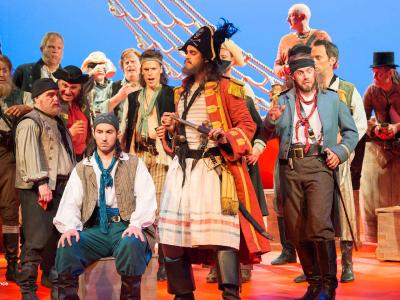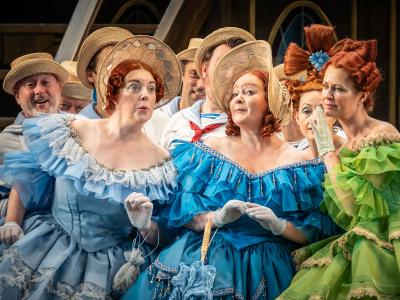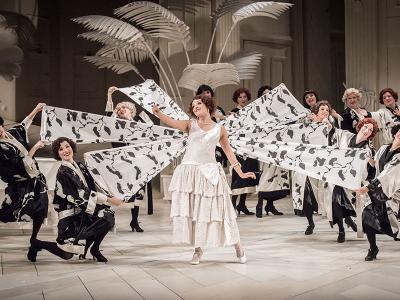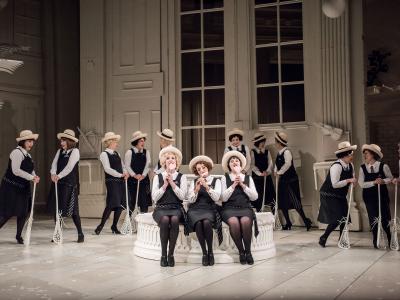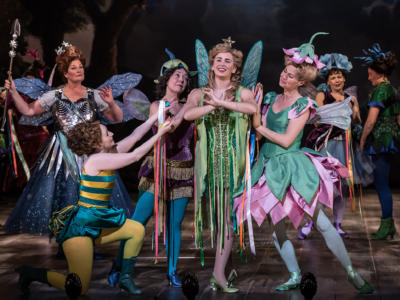The Beginner's Guide to Gilbert & Sullivan
Much-loved British duo, librettist W.S Gilbert and composer Sir Arthur Sullivan, collaborated for over 25 years and created a total of fourteen operas together. Best known for their operas including The Pirates of Penzance and operettas, including the hilarious Iolanthe, find out more about their career below.
They were a Victorian operatic duo
Video
Their quarter of a century long partnership began in 1871, when the pair were brought together by theatre manager Richard D’Oyly Carte. Gilbert and Sullivan are perhaps best known for their comic operas which include The Yeomen of the Guard, The Mikado, H.M.S Pinafore, The Pirates of Penzance and Iolanthe.
The pair were first brought together in 1871 to produce a Christmas extravaganza for West End theatre owner John Hollingshead, but their first operatic collaboration wasn’t until 1875, where Gilbert’s libretto for Trial by Jury was in need of a composer, leading to a first operetta and the start of a working relationship then endured for many years.
The pair’s collaboration reached its peak in the late 1870s and 1880s, following the encouragement of Richard D’Oyly Carte whose company produced popular Gilbert and Sullivan works at London’s Savoy Theatre and elsewhere. The D’Oyly Carte company was dedicated to the Gilbert & Sullivan oeuvre, and continued long after the deaths of composer and librettist, keeping a somewhat moribund performance tradition alive right into the 1970s.
London’s Savoy Theatre was built to stage their operas
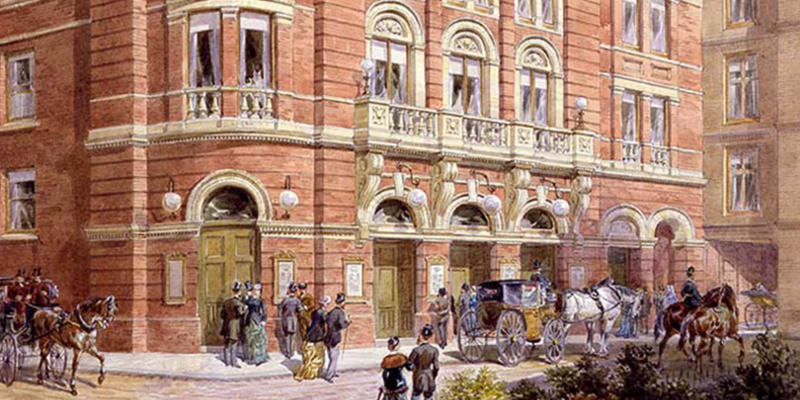
The original facade of the Savoy Theatre, facing the Embankment, London, England.
As well as being a hotelier, composer and theatre manager, Richard D’Oyly Carte was also a talent agent and comic opera enthusiast. The ‘scheme of his life’, as he called it, was to make comic opera as popular in England as it was in France. It was this desire that led him to bring Gilbert and Sullivan together.
In 1881, after nearly ten years of collaboration, Carte decided that he would open his own theatre to showcase the works of Gilbert and Sullivan. This led to some of Gilbert and Sullivan operas becoming known as the ‘Savoy Operas’ – a branch of comic operas developed in 19th London.
Video
When it was built, the Savoy Theatre was at the forefront of innovation. Carte and his manager, George Edwardes introduced numbered seating, free programmes, and a no tipping policy for the cloakroom.
Most impressively, the Savoy Theatre was the first public building in the world to be lit entirely by electricity. Thanks to this innovation, Gilbert and Sullivan’s Iolanthe was one of the first ever productions to use electricity in the staging.
Gilbert & Sullivan works are known as Operettas
Video
Sitting somewhere between an opera and a musical, operettas, or ‘light operas’ flourished in the UK thanks to Gilbert and Sullivan’s operettas, which are still popular with audiences today.
Operetta tends to be shorter than opera and mix song with spoken dialogue, and impressive dance numbers. To put it simply, operettas can generally be described as light operas with spoken dialogue. In comparison, most musicals can be described as plays with singing.
Like their predecessor (and often considered the ‘beginning’ of operetta) Offenbach, Gilbert and Sullivan, favoured satirical operettas. They often poke fun at the establishment and use wit and humour as a way of expressing political opinion.
Some of Gilbert’s fanciful storylines are based on real experiences
Video
As the story goes, when William Schwenck Gilbert was just 2 years old he was kidnapped by Italian bandits. His parents were on holiday in Naples when a couple of men approached the maid looking after baby Gilbert and demanded the child. For a small fortune of £25, his parents were able to win back their son.
Whether the dramatic story is true or not, it had a profound effect on Gilbert’s story-telling – he created Ruth, the foolish nursery-maid from The Pirates of Penzance, and wrote The Gondoliers, which tells the story of the heir to the throne, who was kidnapped as a baby.
London’s West End and America’s Broadway owe a lot to the dynamic duo
Video
Modern music theatre takes many of its structural elements from Gilbert and Sullivan’s operettas, who took a lot of their inspiration from one of the first operetta composers, Jacques Offenbach.
The composer’s catchy melodies, accompanied by the librettists’ witty satire, formed a model that late 18th century musical theatre followed.
Additionally, G&S had an issue with fans of theirs being a bit too enthusiastic in America: within a year of HMS Pinafore opening, hundreds of unofficial, pirated productions began popping up across the pond. The pair had made the mistake of failing to apply for the copyright in the US, so when a score made its way across the sea, there were no restrictions on reprinting, rehearsing and performing the masterpiece – with no royalty payments required. A costly mistake that was never repeated by the pair.
Sullivan was a successful composer in his own right
Video
He might not have been so well known, had he not collaborated with Gilbert, but Arthur Sullivan’s credentials are still pretty impressive as a composer in his own right.
Aged 14, he was the first ever recipient of the Mendelssohn Scholarship, which allowed him to study at the Royal Academy of Music. His graduation piece, The Tempest, was so successful, Sullivan gained near celebrity status overnight. He went on to write a ballet, a symphony, and a cello concerto, not to mention his one-act comic opera Cox and Box, before meeting Gilbert.
Sullivan’s gift for matching Gilbert’s often tongue-twisting words to memorable melody is particularly noteworthy in Sir Joseph Porter’s patter song in HMS Pinafore, or the Modern Major General song from Pirates of Penzance. Take a look at some of the best-loved Gilbert and Sullivan songs.
However it is with The Yeomen of the Guard that Sullivan perhaps reaches his peak, writing music that is both as characteristically whimsical as ever, whilst showing an emotionally maturity that is rarely present in his earlier works.
Their partnership came to an end over a carpet…
Video
Tensions between Gilbert and Savoy manager D’Oyly Carte had been brewing for some time, but it was Carte’s request that £500 for new carpets to be taken out of The Gondoliers profits was the final straw. Sullivan, not wanting to ruin his relationship with Carte, took a back seat in the financial dispute, and he could not understand why Gilbert would make such a fuss over ‘a few miserable pounds’.
Needless to say, Gilbert & Sullivan’s relationship never fully recovered. However, the lasting impact of their legacy is still very much alive today. Gilbert and Sullivan operas remain a firm fan favourite among opera audiences, with the accessible style of an operetta making their productions a great option for first time opera goers.




